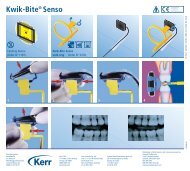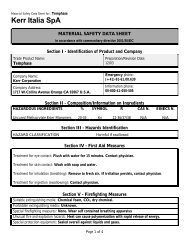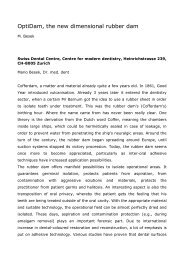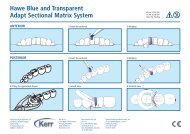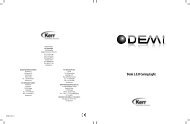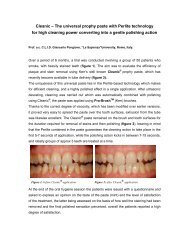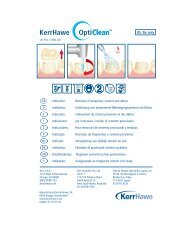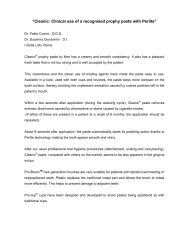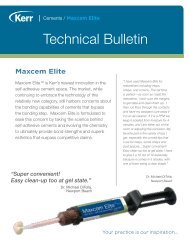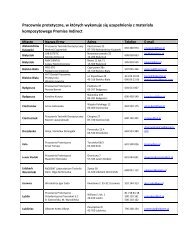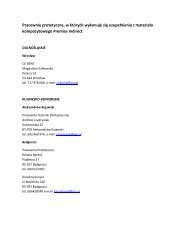Restorative Procedure - Kerr Hawe
Restorative Procedure - Kerr Hawe
Restorative Procedure - Kerr Hawe
Create successful ePaper yourself
Turn your PDF publications into a flip-book with our unique Google optimized e-Paper software.
All you need is <strong>Kerr</strong><br />
Adhesives<br />
<strong>Restorative</strong> <strong>Procedure</strong><br />
Adhesives<br />
Bonding & Adhesion<br />
Prof. David Watts, Dr. Nick Silikas, University of Manchester, UK<br />
The mechanism of enamel bonding is based on a<br />
micro-mechanical bond between the resin and the<br />
phosphoric acid conditioned rough surface of the<br />
enamel.Enamel conditioning remains the most<br />
commonly used method to bond resin-composites<br />
to enamel surface. It provides strong bonds.<br />
Enamel conditioning may be regained by re-etching<br />
the surface and applying the resin, thus recovering<br />
the required shear bond strength at the enamel-resin<br />
interface, and allowing the resin to mechanically<br />
bond onto its surface.<br />
Dentine however has a much more complex<br />
structure than enamel. Prior to dentine-bonding,<br />
the removal or modification of the smear layer is<br />
indicated to clear the openings of the dentine<br />
tubules by conditioning the surface of the dentine.<br />
A fluid adhesive is then applied over the dentine<br />
and cured, ensuring that optimum wetting of the<br />
surface and absorption into the dentinal tubules<br />
is achieved; thus creating an inter-penetrating<br />
network with the demineralised collagen in the<br />
dentinal tubules, hence forming the hybrid layer.<br />
Preservation of the hybrid layer prior to the<br />
application of the hydrophobic resin restoration<br />
is imperative for an efficient bond to form between<br />
the resin and dentine. Therefore, any contamination<br />
of any region of the adhesive system would<br />
evidently jeopardise the integrity of the bond.<br />
The mechanism proposed for this material was<br />
to bond to the organic component of the dentine,<br />
namely the collagen. The first work to investigate<br />
the mechanism of bonding to the dentine was by<br />
Nakabayashi (1). He first identified a layer between<br />
the resin and dentine substrate referred to as<br />
“hybrid” dentine, in that it was the organic components<br />
of the dentine that had been permeated by<br />
resin.<br />
The term “hybrid layer” has now become synonymous<br />
with bonding of resins to etched dentine.<br />
There has been a tremendous amount of research<br />
done on the hybrid layer, its structure, formation<br />
and how it can be improved. This layer has also<br />
been referred to as the “resin-dentine interdiffusion<br />
zone” (2).<br />
Classification<br />
Numerous dentine bonding agents have been<br />
commercially introduced. These changes have<br />
been referred by some people as “generations”,<br />
implying that there was a chronological development.<br />
This can be very confusing. A more consistent<br />
and logical approach is to classify bonding<br />
agents by the number of steps needed to complete<br />
the bonding process.<br />
“Three-step” or “Conventional” systems<br />
This group typically consists of three separate<br />
application steps: etching, priming and adhesive<br />
resin. They are also known as “etch-and-rinse”<br />
7



